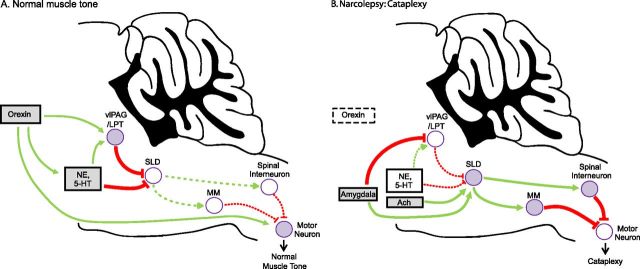Figure 2.
Atonia pathways triggering cataplexy. A, Several pathways suppress atonia during normal wakefulness. Atonia is driven by neurons in the SLD that activate neurons in the spinal cord and medial medulla (MM) that inhibit motor neurons using GABA and glycine. During wakefulness, this atonia system is inhibited by neurons in the vlPAG/LPT and by monoaminergic neurons [e.g., norepinephrine (NE) and serotonin (5-HT)]. The orexin neurons are active during wake and they help maintain normal muscle tone by exciting neurons in the vlPAG/LPT, monoamine neurons, and motor neurons. B, In narcolepsy, loss of the orexin neurons plus strong, positive emotions can trigger cataplexy. Positive emotions may activate neurons in the amygdala that excite the SLD and inhibit the vlPAG/LPT. The SLD may also be activated by cholinergic inputs and a sudden withdrawal of monoamine tone. The SLD then excites neurons in the medial medulla and spinal cord that strongly hyperpolarize motor neurons, resulting in cataplexy. Normally, the many effects of the orexin system and a continued monoaminergic drive to the pons and directly to motor neurons would counter this triggering of atonia, but in the absence of orexins, these excitatory drives are lost and cataplexy occurs. Solid pathways from filled nuclei are active; dashed pathways from unfilled nuclei are inactive. Green pathways are excitatory; red pathways are inhibitory. Ach, Acetylcholine.

